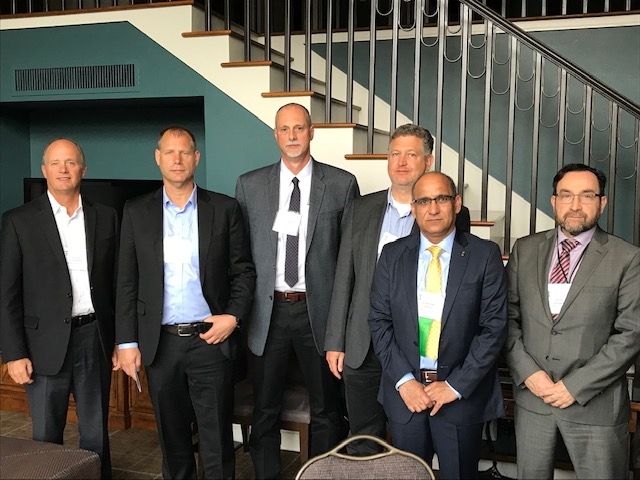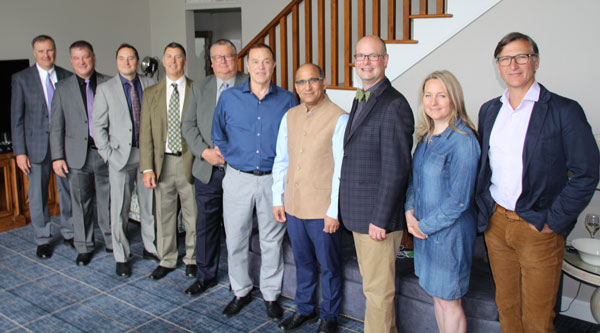
Features
Financial Reports & Markets
Paper
Pulp
PACWEST 2019 focuses on workforce and technology investments
June 11, 2019 By Kristina Urquhart
 PACWEST 2019's opening panel. From left: David Gandossi
PACWEST 2019's opening panel. From left: David Gandossi June 11, 2019 – Investments in people, technology and assets were the focus of PACWEST’s annual pulp and paper conference last week.
The three-day event, held June 5-7 at the Fairmont Chateau Whistler in Whistler, British Columbia, saw 281 delegates from mills across Canada and an additional 61 participants in the spousal program.
Anchored by technical sessions focused on emerging technologies, machine efficiency, mechanical pulping, the fibre line, bioproducts and energy, and innovation and research, PACWEST also included a trade fair, roundtables for maintenance managers and pulp machine superintendents.
David Chalk, a futurist and business growth expert, delivered a rousing, wide-reaching keynote exploring the impact of technology, from artificial intelligence to blockchain to cybersecurity.
The people problem
PACWEST 2019 opened with a forum addressing this year’s theme, “The Future is Now – Investing in People, Technology and Assets,” with panellists discussing the industry’s dual challenges of a retiring workforce and aging equipment.
“Canada is falling behind in terms of technology,” said Andrew Hall, manager, forest industries at Wood., a consultancy for manufacturing industries. He said that parts of the Canadian pulp and paper industry are heavily invested in declining grades and outdated assets, and pointed to foreign competitors who are widening the technology gap with large investments.
Hiring workers equipped with leadership and/or technological skills is a good first step for future-proofing mills, Hall said, because it requires less capital than new assets or technology. “We need people capable of maximizing profitability.”
The challenge, of course, lies in attracting, training and retaining those skilled workers.
Dr. Mark Martinez, director for the Pulp & Paper Centre at UBC, said that cultivating new recruits to pulp and paper requires ongoing changes to the curriculum, along with investments in innovation and research.
“We have to look ahead to what the needs of pulp mills will be in 20 years, so we can educate [people] now and make them into the future leaders,” he said.
David Gandossi, president and CEO of Mercer International, suggested that mills work towards eliminating unsafe and lower-end jobs. “Invest in retention and you’ll see the greatest return,” he said.
Several panellists agreed that creating an environment that prioritizes continuous training, leadership development, safety and open communication is integral to attracting talent and creating a culture that people want to work –and remain – in.
Hall said he’s consulted in mills where half the employees aren’t speaking to the other half – and it leads to not only redundancies and inefficiences, but it drains the mill of any workplace culture. He suggested management consider an operations model similar to what some mills have adopted in Europe, whereby business unit managers work next to a centralized control room, allowing them to be much closer to the process and to deal with problems in real-time.

The PACWEST 2019 executive committee with futurist and keynote speaker David Chalk (fifth from right). Photo: Scott Curry/PACWEST
Messaging the industry
Like PaperWeek Canada and PaperCon before it, PACWEST’s forum participants discussed a need for industry to rebrand, ultimately creating a consumer-facing campaign that tells the story of pulp and paper in Canada.
Amid the growing global concern about plastic waste, “urban dwellers need to understand that the forestry industry is important to the environment,” Gandossi said. (Three days after the PACWEST conference ended, the Canadian government announced a national ban on single-use plastics.)
Gandossi called on mills to promote their activities in their own cities, in neighbouring Indigenous communities, and with government stakeholders. “We need to focus on transparency and building trust in communities,” he said.
The panellists suggested that the industry as a whole look to organizations such as Two Sides in the U.K. and the Paper & Packaging Board in the U.S., which both run marketing campaigns that demonstrate the paper industry’s sustainable forest practices, commitment to renewable resources, and the overall value of forest products.
“We still believe pulp and paper is an attractive industry,” said Brian Baarda, CEO of Paper Excellence. “Some people say it’s a sunset industry…but we like to think of it as a sunrise industry.”
Award winners revealed
PACWEST 2019 concluded with a dinner and dance along with its annual awards program for best technical papers presented at the conference:
H.R. MacMillan Trophy for Best Paper
Koowar Singh, Kevin Kirby, G.O’Reilly, Mercer Celgar
Improving Pulp Machine Efficiency at Celgar
Runner-up
Kerry Betz-Stablein, Matthew Jensen, Adam Lancaster, Canfor Pulp
Maggie Grierson, Mantech
Fast COD Analyzer for Improved Process Control and Savings
Best Supplier Paper
Dave Tunnah, SEMAN Group
Power Quality Improvement
Best Novice Paper
Tika Tedjamukti, Pan Pac Forest Products
Dan Davies, Evonik Canada
Optimising BCTMP at Pan Pac Forest Products
Best Student Paper
Mohammed Shanb Ghazani, UBC
Method for Continuous Fractionation of MFC
An executive committee with representatives from Alberta Newsprint, Mercer Celgar, West Fraser Hinton Pulp, Catalyst Paper, Oval International, Valmet, Kemira and Allnorth, organized the PACWEST 2019 conference alongside the IBMP, an group of industry suppliers.
PACWEST 2020 will be held May 27-30, 2020 at the Fairmont Jasper Park Lodge in Jasper, Alberta.
Print this page